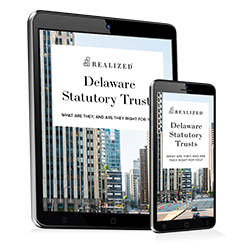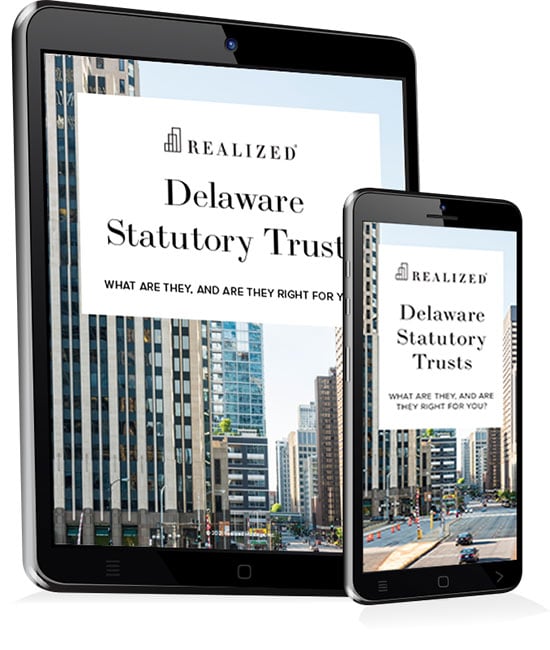
Not putting all your eggs in one basket is an adage dating back to the 17th century. At the time, it alluded to the issue of putting a hen’s eggs in one basket. The danger was that, if the basket fell and the eggs broke, everything was lost.
Fast-forwarding four centuries, the adage is still true, especially if you substitute “investments” for “eggs,” and “portfolio” for “basket.” To translate — it’s a better idea to have many investments for your portfolio, rather than focusing on one single investment type. When it comes to real estate investments, the Delaware Statutory Trust (DST) can be a good tool for risk diversification. Because of its design, the DST allows you to direct capital toward different types of real estate, rather than sinking everything into one asset.
The DST Definition
A Delaware Statutory Trust is an investment trust entity overseen by a sponsor (a real estate company with experience in the buying/selling and operations of real estate). The DST buys, sells, maintains, and owns the property/properties, with a bevy of accredited investors buying undivided fractional interests in the entity. Owning a beneficial interest in a real-estate-asset-owning DST is considered a direct real estate investment, thanks to IRS Revenue Ruling 2004-86. Boiling this down, it means that as a DST investor, you can enjoy the advantages of real estate ownership without having to worry about “trash and toilets” maintenance.
Another potential benefit is that a DST can have an unlimited number of investors, unlike tenant-in-common set-ups (TIC), which are capped at 35. Additionally, you can sell your DST interest without approval from other DST co-owners.
Furthermore, when the DST sells its property or properties, you can defer taxes on the capital gains by putting them into another DST investment. In our experience, such exchanges from one DST into another can be easier than exchanges between fee-simple properties.
Spreading the Risk
Unlike a direct investment in a real estate asset (which could be considered the same thing as putting all of those eggs in a single basket), the DST set-up means you can acquire interests in multiple properties that otherwise might be outside of your financial reach. You can split your capital between different DSTs that might own office, multifamily, and retail properties. Or, you can find a single DST that owns multiple properties. Either way, your risk is diversified across multiple properties.
How, then, do DSTs differ from other diversification investments, such as real estate investment trusts, or Real Estate Investment Trusts (REITs)? Certainly, with both structures, you are investing in entities that, in turn, buy and maintain real estate. Both set-ups are considered passive investments. But, when you invest in a REIT, you acquire shares of a company that owns real estate, as opposed to buying a beneficial interest that is considered a direct real estate investment. In other words, you own that company’s stock, rather than the actual real estate. It also means that capital gains from the sale of a REIT’s shares aren’t eligible for the 1031 Exchange tax deferral, unless you decide to undergo the laborious process of converting your REIT shares into UPREIT units.
Investor, Beware
While DSTs can be a good way to diversify your investment eggs among different real estate asset baskets, DSTs are investments. And, those investments have the following downsides.
Capital availability. Once the DST offering is closed, it can’t collect any more funds. If, for example, an underlying real estate asset develops a leaky roof, that roof will need to be repaired from real-estate-generated profits, as opposed to additional investor funds. This could take a bite out of the property’s projected cash flow, and your own projections.
Risk tolerance. Once again, an investment in a DST is an investment in real estate. Real estate of any kind is subject to market, leasing, and competition factors. If your risk tolerance for direct real estate investment is low, you might want to stay away from a DST.
Illiquidity. Much like direct real-estate investments, DST investments are long-term, with your equity tied up for at least five-to-seven years. Yes, you can sell your DST interest, but this isn’t something you just go out and do. The sales process is time-consuming, involving your sponsor and possibly a secondary-market specialist. Buyers might not be interested in your interest. As such, don’t assume you can take cash out of the DST before the property sells.
The Investment Objectives
Before you direct your capital anywhere, it’s important to consult with your financial advisor or accountant to understand your investment goals and objectives. Many experts will point out that portfolio diversification is important to help ensure continued cash flow and appreciation. If your investment target involves real estate, spreading your eggs — or rather, your risk — through multiple DSTs proves to be a positive decision.
Diversification does not guarantee a profit or protect against a loss in a declining market.
This material is for general information and educational purposes only. Information is based on data gathered from what we believe are reliable sources. It is not guaranteed as to accuracy, does not purport to be complete and is not intended to be used as a primary basis for investment decisions. It should also not be construed as advice meeting the particular investment needs of any investor.



